All published articles of this journal are available on ScienceDirect.
An Analysis of the Main Causes of Delays in the Completion of Road Construction Projects: A Case Study of Tanzania
Abstract
Introduction
Completing road construction projects in time is a challenge for developing countries, specifically for Tanzania, where great economic costs result from difficulties in identifying and reducing the factors that cause the delay.
Methods
This study addresses factors that cause the delay of a road construction project in Tanzania and proposes some methods that could potentially reduce this delay. A structured questionnaire was drawn up through an interactive online workshop with the help of experts and professionals from the road construction sector in Tanzania, and follow-up interviews were conducted.
Results and Discussion
In addition, the first results were analyzed, and the factors identified were combined into five important groups, namely, client-related, consultant-related, contractor-related, design-related, and external factors. These were the main contributing aspects to delays in road construction projects in Tanzania.
Conclusion
Furthermore, from across these groups, six significant causes of delays emerged, and these were inadequate access to finance and delayed payments for completed work, financial problems or difficulties, unwillingness or inability to sustain operations over long periods of non-payment, an unrealistic program of works (Works Schedule), inadequate site management, and political interference.
1. INTRODUCTION
Many public road construction projects across Tanzania have been conducted with significant public spending over the last decade as part of the government's national development program. Roads are fundamental infrastructure for socio-economic growth, enabling society to connect to goods and services cost-effectively. Annual investments in road infrastructure construction, management, maintenance, and restoration are important compared to designations for other competing socio-economic infrastructure facilities. The construction industry is a mechanism for countries to achieve urban and rural development goals [1]. It has a huge impact on the economy of any country [2]. Cost, time, and quality are key indicators for project outcomes. Delays in the completion of road construction projects are a universal phenomenon. In general, cost overruns result from these projects. Delays affect clients, contractors, and consultants, leading to mistrust, litigation, and cash flow issues. This problem is not unique to developed countries but also exists in most developing countries [3]. A project may not be considered worthy until it meets the applicable cost, time, and quality constraints. However, most construction projects will ultimately achieve their purpose over time [4]. In 2014, Tanzania's transport sector contributed 8.1% ($ 2.8 billion) to the country's real GDP, and it increased by 33% to $ 3.8 billion in 2018 [5, 6]. According to Al-Najjar [7], some of these problems are:
(i) Too many workers compared to the number of projects
(ii) Continuous rise in the prices of materials
(iii) Contractors’ financial position and
(iv) Unstable political situation
In Tanzania, general observations show that delays are common in completing road construction projects. This study presents the results of a survey aimed at determining the causes of these delays. Chang (2002) argues that “identifying the cause is often the first step to solving a problem, after which corrective action can be taken.” The present study and its results can guide efforts to improve the construction industry's performance. The main objective of this study is to analyze the main causes of delays in the completion of road construction projects implemented by the Tanzania National Roads Agency (TANROADS). Specifically, the study is confined to the following two specific objectives:
(i) To identify the main factors causing delays in road construction projects in Tanzania using literature review and data analysis.
(ii) To determine strategies/solutions to overcome delays in road construction projects in Tanzania.
Various research papers have examined and discussed the causes of construction project delays differently. Some have identified the main causes of delays in different countries, and project types and others have explored approaches to analyzing delays and suggested ways to reduce them. Delay is a period beyond the time specified in a contractual agreement or the date the contractor and client decided to submit a project. Overtime is a delay beyond the contractor's planned completion date [8]. Delays can therefore be viewed as “events” affecting a project such that it falls behind its planned schedule. This is a common problem in the construction industry. Due to the dynamism of construction projects and the associated high level of uncertainty, delays in construction projects are unavoidable, especially in Tanzanian government agencies [9], where the projects entail a structured process of constructing, maintaining, and rehabilitating public or privately owned structures or infrastructure. This process may include feasibility studies, design, procurement, financing, and physical construction. The construction process is characterized by time (normally short), pre-determined quality of the product, fixed budget, and short-term relationships among the parties to the contract [10]. Every construction project has a distinctive set of uncertainties related to the nature of the project, tasks, the contract, and the assemblage of the organization managing the contract [6]. Additional uncertainties in construction projects arise from the weather, acts of nature, and the tension generated by the temporary nature of the project-specific organization structure and dimensions [6].
There are mainly three types of construction project delays: non-excusable, excusable, and concurrent [11]. The analysis of project delays is vital to support decisions on the reasonable compensation of contractual claims to parties to the contract. The existing delay analysis methods use different appraisal techniques, and likely different analysis methods may result in different outcomes for the same delay scenario depending on the unique requirements and the method's application [12].
A quantitative and qualitative analysis of construction delays in Tanzania was conducted by [13]. Results indicated that the main causes of delay in road construction projects were politicians’ interference, poor construction process management, inadequate designs, resource unavailability, and poor contractual relations. Similarly [14], surveyed the main reasons for the delay in completing traditional contract-type road construction projects from the perspective of construction contractors and consultants. Survey results showed that contractors and consultants agreed that owner intervention, contractor inexperience, inadequate financing and payment, low labor productivity, slow decision-making, inadequate planning, and poor performance of subcontractors were the ten most important factors.
Previous studies [15, 16] suggest that delays in road construction projects in Tanzania are a common problem. According to [17], projects in Tanzania are delayed by an estimated 110% of the time, as outlined in the contract. The general indication is that several factors can cause delays, which may vary from project to project. However, previous investigations failed to determine the direct causes of the delays. They integrated the opinions of professionals working with clients, contractors, and consultants and used limited resources and methods. In order to study the Tanzanian construction experience, 63 variables were identified from previous studies and grouped. Based on the results of the survey, suggestions were made to alleviate the identified problems.
2. MATERIALS AND METHODS
In order to study the Tanzanian construction experience, 63 variables were identified from previous studies and grouped. These have been categorized as follows:
(i) Design–associated factors include inadequate site surveys, design errors, ambiguities, the complexity of the project design, inadequate and/or unclear design information, incongruous site conditions, incorrect selection of technology, design modifications, and unpredictable construction circumstances and customer requirements/scale of construction misunderstandings.
(ii) External Factors include extreme weather, changes in laws and regulations, corruption, a shortage of good materials inside the project corridor, the need for advanced equipment and resources that are often unavailable on the market, unpredictable economic conditions (such as exchange rate, inflation rate), transportation difficulties (logistical issues in supply), political interference, labor shortages, and a scarcity of construction equipment.
(iii) Client Factors include delay in site handover (due to right-of-way obstructions), poor communication and planning, sluggish decision-making, finance, slow payments for completed work, unrealistic contract length projections, poor contract management, lack of working knowledge, lack of coordination with suppliers, contract adjustment, and procurement method (International Competitive Bidding).
(iv) Contractor Factors include an unrealistic work program, financial difficulties, insufficient management of site areas, insufficient sub-contractors, construction methodology, inaccurate preparation of projects, inadequate contracting experience, material quality, and unrealistic cost estimates.
(v) Consultant Factors include poor mobilization of competent personnel, poor contract management, delays in the preparation and approval of drawings, insufficient quality control, unrealistic cost estimates (low bid), lack of experience in the practice of a standard form of contract, inexperienced site personnel, delays in making decisions, incomplete documents, and financial instability.
Participants were asked to rate the importance of each factor based on their own experiences in the survey. Questions were written using a 5-point Likert scale. Compared to the single-scale method, a previous study by [18] supports Likert scales as an efficient measure of providing effective information from data. As part of the process of improving the survey content, a pilot survey was conducted to evaluate the completeness and consistency of the questions, and the results of the survey were used to improve the survey content. Next, the questionnaire was emailed to experienced professionals who had participated during project implementation. These professionals would provide us with the required information for our study. The questionnaire survey was conducted between July 3, 2021, and August 3, 2021. The population surveyed included consultants, clients, and contractors with valid registrations with the Tanzanian Contractor Registration Board (CRB). For this report, a sample of 15 government-funded projects was selected for detailed analysis. The projects were selected based on the project history and data they contained for our study. These data projected commencement date, completion date, budget reports and final accounts. The Project Completion Report forms an integral part of the final documents produced for the project and is used by senior management to assess the success of construction activities and applied methodologies that were incorporated during the execution of works to identify best practices for future projects. (Table. 1)
2.1. Ranking of Causes of Delay Using (RII)
Classifying answers by order of meaning is a part of logical analysis that enables interpretation of participants' answers obtained through questionnaires. We used the method of evaluating traits using the relative importance index (RII) formula [19], [20];
 |
Where;
RII = relative importance index,
W = weight of each attribute,
Σw = summation of weights of each attribute,
A = is the highest weight score (5 in this case),
N = total number of respondents.
It was used to measure the relative value of the causes and consequences of different delays. In this analysis, the same approach was used in other classes (e.g., contractors, project engineers, consultants, owners, and field supervisors). Attributes are evaluated in descending order by the RII approach, from the most important to the least important. The RII with the highest score was given a ranking of 1 (significant factor), and the RII with the lowest score (lowest important
| Project ID | Contract Type | Original Completion (Days) | Revised Completion (Days) | Percentage Time Delay (Days) | Original Contract | Revised Contract Amount | Percentage Increase in Cost ($) |
|---|---|---|---|---|---|---|---|
| Amount (Million $) | (Million $) | ||||||
| 1 | Design-Bid-Build | 1,129 | 1,295 | 15 | 27.97 | 42.03 | 50.3 |
| 2 | 1,077 | 1,675 | 56 | 27.89 | 29.39 | 5.4 | |
| 3 | 991 | 1,212 | 22 | 32.83 | 38.49 | 17.2 | |
| 4 | 883 | 1,460 | 65 | 27.97 | 34.14 | 22.1 | |
| 5 | 920 | 1,435 | 56 | 28.32 | 45.12 | 59.3 | |
| 6 | 717 | 1,148 | 60 | 35.88 | 38.78 | 8.1 | |
| 7 | 698 | 846 | 21 | 33.08 | 39.4 | 19.1 | |
| 8 | 928 | 1,435 | 55 | 29.45 | 43.43 | 47.5 | |
| 9 | 884 | 1,016 | 15 | 25.21 | 27.54 | 9.2 | |
| 10 | 759 | 1,124 | 48 | 30.57 | 38.32 | 25.4 | |
| 11 | 832 | 1,210 | 45 | 27.07 | 30.5 | 12.7 | |
| 12 | 994 | 1,125 | 13 | 34.7 | 36.8 | 6.1 | |
| 13 | 986 | 1,157 | 17 | 22.45 | 24.76 | 10.3 | |
| 14 | 842 | 913 | 8 | 30.39 | 34.42 | 13.3 | |
| 15 | 731 | 1,042 | 43 | 27.33 | 38.18 | 39.7 |
factor) was given a rank according to the number of attributes. Doloi [21] says that “the first step in evaluating the relative values of various quantitative variables is a multivariate regression analysis of the results.” However, since the data are quite multicollinear [22], it was reported that it was impossible to consider the results of multivariate regression analysis alone as conclusive. This was because most of the developed features and surveys are interconnected [22], [20], and the multicollinearity problem was solved using factor analysis methods. Researchers used relative significance indices (RIIs) and correlation coefficients to estimate the data and variables contributing to project delays [21]. It was found that the Relative Important Index (RII), in relative order of criticism, strongly reflected respondents' perceived value [23]. Another study evaluated the perceived value of an attribute using descriptive analysis to statistically compare and contrast effects. According to [20] and [24], there are no best methods for evaluating mean and default variance characteristics. Ekanayake and Perera [25] used the Multi attractiveness Utility System (MWU) to determine the average rating of each respondent in Malawi. These include the mean assessment, the relevance assessment of the RII criteria, and the overall assessment of conformity (OSS). Data were analyzed using RII and Spearman rank correlation coefficients.
3. RESULTS
The data analysis protocol was designed to determine the relative importance of various factors leading to construction delays and strategies for reducing them. Data were analyzed in two steps: measuring the relative importance index and evaluating each element according to RII.
3.1. Analysis of the Data from the Questionnaire Survey
A total of 63 factors contributing to the delay in the project implementation were defined and categorized into five groups: Client-Related Factors, Consultant-Related Factors, Contractor-Related Factors, External Factors, and Design-Related Factors. Literature review and preliminary review of project documentation were used to identify these five groups. Respondents were allowed to add another category to the survey but did not use it.
3.2. Client-related Factors
The RII of client-related factors ranged from 0.501 to 0.905, showing that all client-related factors significantly impacted project time. The client-related factors are summarized in Fig. (1). This figure shows the ratio of RII and the importance of each element within a category. Difficulty in financing and paying for completed work, making decisions on financial matters, delays in delivery of the site (problems caused by barriers to right-of-way), unreasonable expected contract length, procurement process (granting the lowest bid price) and insufficient contract management emerged as the most important reasons for delays.
3.3. Consultant-related Factors
According to the survey, the RII of consultant-related factors ranged from 0.580 to 0.707, indicating that all consultant-related factors would cause project delays. The factors related to consultants are summarized in Fig. (2). The top six key factors were decision-making delays, drawing preparation and acceptance delays, unwillingness/inability to operate long-term in the absence of payment, slow order delivery, insufficient mobilization of training staff, and poor contract management.
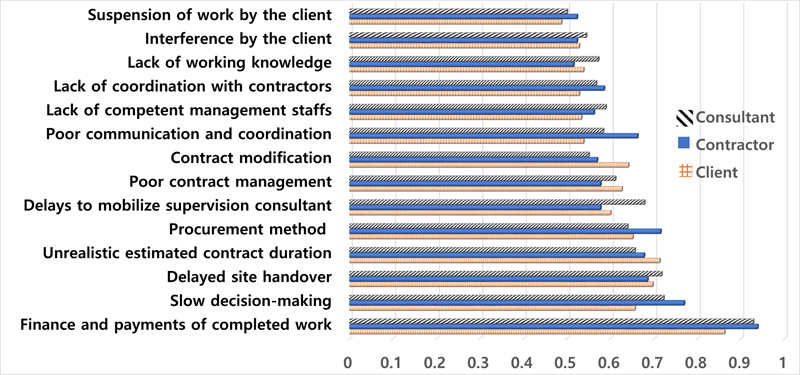
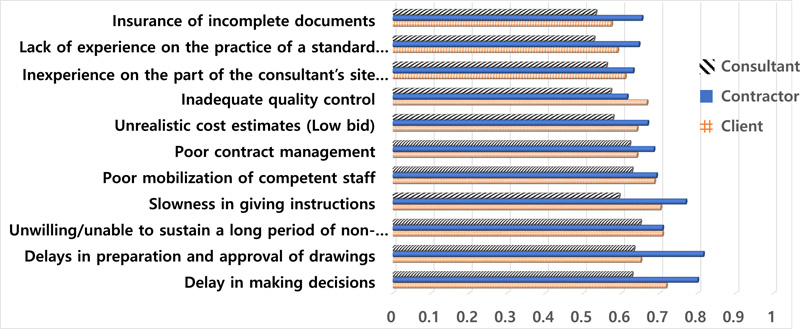
3.4. Contractor-Related Factors
The RII for contractor-related factors ranged from 0.558 to 0.879, indicating that all factors significantly contributed to project delays. The factors related to the contractor are summarized in Fig. (3), which shows the RII and the percentage of importance of each factor in the category. The most important factors were financial problems, unwillingness or inability to maintain long-term unpaid payments, unrealistic project plans (project schedule), insufficient site management, unrealistic cost estimates (low bids), and poor project planning.
3.5. Design Related
The RII of design-related factors ranged from 0.535 to 0.715, indicating that all design-related factors would cause project delays. Fig. (4) summarizes the design-related factors. The figure shows the RII and the percentage of importance of each factor in the group. The top five factors were inadequate site survey, design changes, uncertain construction conditions, incomplete design (partial submission), poor design, and inconsistent site conditions.
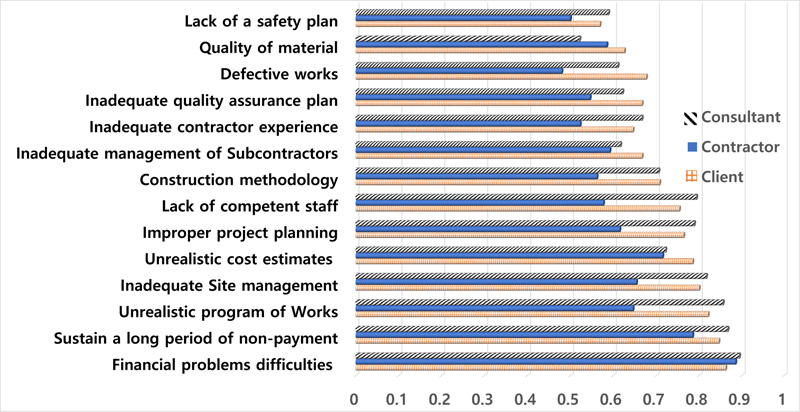
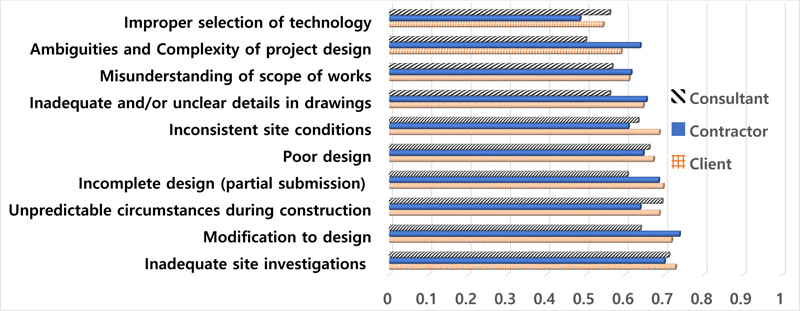
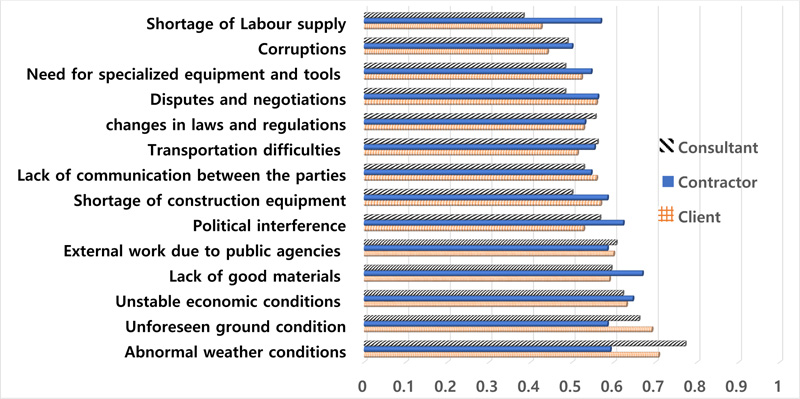
3.6. External Factors
According to our research, the RII for external factors ranged from 0.448 to 0.701, indicating that all related external factors were important aspects leading to project delays. These factors are summarized in Fig. (5). The six main factors in this category were irregular weather conditions, unforeseen terrain conditions, uncertain economic conditions, lack of high-quality materials in the permissible corridors of the project, dependency on third-party, public institutions (roads, infrastructure, and public services), and political interference.
4. DISCUSSION
This research was an in-depth analysis of responses to a questionnaire to investigate the factors that cause delays in construction projects. The review's results include a collection of key messages supporting stakeholders' efforts to manage road projects and ensure their successful use. Based on the ranking and careful comparisons with previous studies' results, there is a high risk of increased delays in the road construction project in Tanzania, reducing the construction industry's capacity to execute the plans effectively. The findings indicate that the causes of project delays are evenly distributed among all contract parties (contractors, consultants, and clients), external factors, and technological, administrative, abilities, behavioral, and attitude aspects of the project participants. Efforts must be made to reduce the incidence of the same to boost the construction sector's efficiency. According to detailed interviews by experts, assessments in Tanzania are based on past results and financial conditions, and the criteria used to evaluate contractors' potential performance qualifications are subjective and cannot guarantee future project performance. This is probably due to the dynamic and competitive business environment of construction projects.
Time management is vital in a construction project, so anticipating delays can be critical to the project's success. Before the tendering phase, it is necessary to develop a probabilistic lead time analysis model for construction projects as a decision support method for contractors. The analysis identified the six most important delay factors out of sixty-three, which are explained in detail below.
(i) The most critical one is the failure of the client to pay the contractors timely. Appropriate funding levels should always be calculated during the project planning stage to ensure that the contractor receives regular payments for completed work. Clients can work closely with funding agencies and institutions to ensure timely payment.
(ii) The contractor’s financial difficulties and poor site management are probably due to imperfect procurement procedures, which may allow for the procurement of incompetent contractors. An in-depth review revealed that Tanzania’s procurement procedures provide the ability to screen potential contractors before awarding and successfully executing contracts; however, due to limited resources, most projects have not completed this process. According to [20], the successful investigation of the contractor’s capabilities before awarding the contract is critical to the success of the project.
(iii) Delay in payment to the contractor or non-payment over the long term will affect the contractor's financial position. If the situation is not communicated clearly to the contractor, they may choose not to pre-finance the project to reduce risks. However, regardless of the capabilities of the individual contractor, under no circumstances should the contractor be expected to finance the project in advance rather than constructing the project in line with the terms of the contract.
(iv) The problem of an unrealistic work program may be due to an unrealistic project duration determined by the client or insufficient knowledge and experience of the contractor. To overcome this problem, the client must use scientific methods to research and realize a realistic project schedule. However, to avoid working with incompetent contractors, the client must improve the procurement and monitoring procedures, including improving the evaluation standards, effective project monitoring, and evaluation procedures, to find problems early and take timely measures to alleviate them.
(v) Inadequate site management is related to the capabilities of the deployed monitoring team and the support methods or tools used in project management. Labor shortages, corruption, client suspension of work, the need for specialized equipment and tools that are not normally available on the market, and client intervention are all critical in other studies. In the future, we must carefully monitor the impact of these factors on project performance.
(vi) The least critical factor in this study is political interference where a politician can issue verbal instructions on-site regarding stoppage of work or change of work item without considering contract clauses. Many politicians have used road construction projects to gain popularity and garner votes. This has led to delayed completion of some projects. Politicians will occasionally instruct a contractor to suspend a project while on-site or to change some of the work and add non-contract work without involving the relevant authorities, all for the sole purpose of appeasing the people in the project area. If the politician's wishes are accepted, changing the scope of work, and creating an addendum or variation order leads to many projects being delayed and an increase in cost.
CONCLUSION
The parties to the contracts (contractors, consultants, and clients) will need to pursue several actions intended to (i) consolidate the achievements to reduce delay to enhance the value for money of road projects and (ii) strengthen the capacity of implementing agencies entrusted to manage road construction projects to be completed in time to manage value for money. To improve the performance of the construction industry in Tanzania, each stakeholder must have the following responsibilities:
(i) The client must obtain project financing to satisfy all contractual commitments, including payment of due certificates, to minimize outstanding payments to contractors, which directly impact the customer's entrepreneurial progress and project results. The government needs to ensure that project funds are available and released from donor agencies before the commencement of projects.
(ii) Provide guidelines to enhance the capacity of implementing agencies to plan and manage the execution of road construction projects. The implementing board should support interventions to develop comprehensive road construction standards in the country and develop a procurement and contract administration manual for road construction projects. Currently, there is only a road maintenance manual.
(iii) The actual scope of work and time of the project should be measured during the feasibility and design stages to help decision-makers accurately foresee future project risk before engaging in the project and/or allocating sufficient resources before beginning the construction phase to avoid variation orders and addenda that contribute to delays.
(iv) Contracting authorities should ensure that contractors are not selected solely based on the lowest bid. The chosen contractor must have ample expertise, technological capabilities, financial capability, and labor to complete the project.
(v) Streamline the procedures for conducting joint inspection and measurement before payment to ensure that all parties involved in these projects adhere to the procedures and develop a good system for site management and proper supervision of project planning and scheduling.
(vi) Appoint supervision teams (clients and consultant personnel) with the required knowledge and experience to manage the construction process and establish an effective communication strategy that allows easy flow of information and traceability of a communication breakdown to quickly identify and mitigate delays. The system should provide both contemporary records and enhance the learning process.
(vii) The government, through parliament, must develop a long-term road construction policy and laws that direct politicians not to interfere or provide any guidance on road construction. There should also be contractual clauses in the contractor directing policy contract documents. This will eliminate the problem of project delays and the resulting cost to the government.
Due to time and resource limitations, this study might not be exhaustive enough to provide more reliable data and solutions. More studies are needed on best practices for determining the causes of delay in the completion of road construction projects in the following areas:
(i) A similar study could be conducted incorporating more project datasets to identify other significant factors that cause project delays in the completion of road construction projects in Tanzania, including those factors found to be the least significant in this study and other important factors excluded in this study.
(ii) This study focused on Tanzanian roads managed by TANROADS, meaning that a similar study can be conducted on roads led by Tanzania Rural and Urban Roads Agency (TARURA).
(iii) A study to establish the best and most efficient communication between the parties to the contract showed the information flow, traceability, and mechanism for identification of communication breakdown and the means to provide contemporary records daily.
(iv) A study investigates the overall procurement methods, establishing important factors influencing project construction duration and providing a proper method for determining project durations to arrive at a practical contract duration.
In this study, a large data set was gathered and used. However, there are some limitations of this study. We tried to connect our study using email interviews, but poor internet connectivity discouraged some of our respondent's from participating and delayed their responses, and system crashes resulted in the elimination of some data.
ETHICS APPROVAL AND CONSENT TO PARTICIPATE
Not applicable.
HUMAN AND ANIMAL RIGHTS
Not applicable.
CONSENT FOR PUBLICATION
Not applicable.
AVAILABILITY OF DATA AND MATERIAL
The authors confirm that the data supporting the findings of this study are available in the article.
FUNDING
This work was supported by the Ministry of Education of the Republic of Korea and the National Research Foundation of Korea (NRF-2020S1A5C2A01092978).
CONFLICT OF INTEREST
The author declares no conflict of interest, financial or otherwise.
ACKNOWLEDGMENTS
Declared none.


